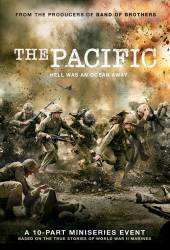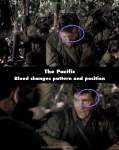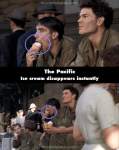Continuity mistake: The Pacific Complete Series, Episode 6: A soldier kneels down next to a covered dead soldier's body to check his bottle of water. When uncovering the body, the face of the dead soldier faces to the right. In the next shot, the face is to the left, and then before being covered again the face goes back to its original position of facing to the right. 10m:30s to 11m:10s.
Continuity mistake: In Episode 4, after a Japanese counter attack, Leckie is talking to two other soldiers. In the first shot you see him walk to where the .30 cal machine gun position is located. The machine gun is uncovered, then after the camera switches to the dead Japanese and back to machine gun, it's covered by a water proof tarp. Then it shows Leckie again as he's lighting a cigarette with just the tip of the .30 cal machine gun muzzle uncovered.
Factual error: John Basilone was actually a Sergeant when he won the Medal of Honor at Guadalcanal, but is shown wearing the insignia of the higher rank of Platoon Sergeant. However, when his medal citation is read out it does give his correct rank (although senior sergeants in the US forces are commonly addressed simply as "sergeant", official citations give their full rank).
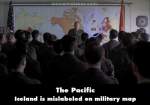
Factual error: On the map behind the colonel during the first scene, Iceland is labelled as being under Nazi control. This is incorrect, as the British were in control of the country during the whole of the war. (00:05:10)
Factual error: The map shown has U.S. interstates displayed, but the U.S. interstate system wasn't developed until the 1950's. (00:06:30)
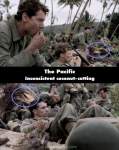
Continuity mistake: When we see the guy trying to open the coconut with his bayonet, his blade is either on top of the coconut or digging into the coconut depending on the shot. (00:21:20)
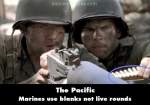
Revealing mistake: Near the end of the battle at the end of the episode, we see some Japanese troops coming out from the jungle. The Marines then shoot a machine gun, killing them. But pay attention to the ammo belt. All the bullets are blanks. (00:38:50)
Factual error: The climax of the first episode, The Battle of The Tenaru River, is not historically accurate. Leckie did not run about shoring holes in the Marine defensive line. The real heroes of the engagement known variously as The Battle of Alligator Creek (a misnomer - no alligators in the South Pacific), Battle of the Tenaru River (mismarked on Marine maps, properly known as The Battle of The Ilu a tidal lagoon) were Marines Leroy Diamond, Al Schimd and John Rivers. These men accounted for over 200 Japanese KIA. All three paid dearly. Rivers was killed, Diamond sustained over 8 bullet wounds and Schmid was blinded. For their gallantry in action the three were awarded the Nation's second highest honor the Navy Cross. An accurate depiction of this battle was in the movie "Pride of the Marines."
Continuity mistake: In the scene where John Basilone goes looking for his friend Manny. Basilone has 3rd degree burns on his left forearm and left hand but in the shot he is walking through the jungle holding a pistol tightly in his left hand and his canteen is on his right side as he walks past a group of trees. The next shot he is continuing walking through the jungle but the gun is in his right hand (which isn't burned) and his canteen has also switched sides as he walks past the same group of trees.
Factual error: General Alexander Archer Vandegrift, who awards John Bassilone the metal of Honor (MOH), is wearing the MOH ribbon himself. General Vandegrift was not awarded the MOH until 1943, after Sgt. Bassilone. (00:21:26)
Continuity mistake: When Jay realises he pooped himself, his M1 Carbine rifle is on the ground. In the next shot when he looks up to tell the other soldiers what happened, you can see the barrel poking out from the bottom of the screen.
Factual error: Robert Leckie returns to Bergen County, N.J. in the mid '40s. While talking to his dad he says of that afternoon "Bergen Catholic plays Don Bosco Prep." Bergen Catholic wasn't established until 1955, and while Don Bosco did exist in the 1940s, it didn't have a football program until the late 1950s.
